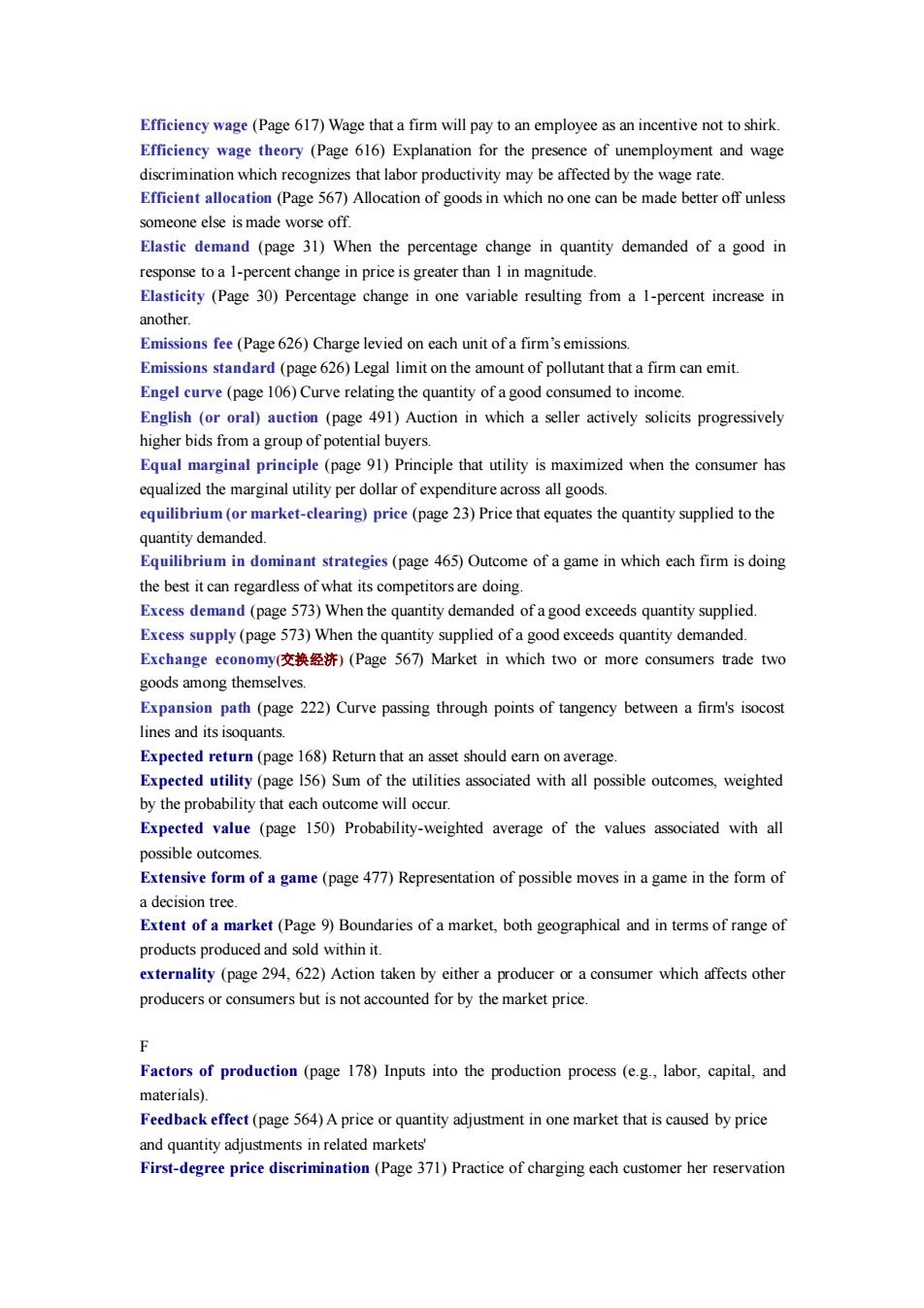正在加载图片...

Efficieney wage(Page 617)Wage that a firm will pay to an employee as an incentive not to shirk. discrimination which recognizes that labor productivity may be affected by the wage rate. Efficient allocation (Page 567)Allocation of goods in which no one can be made better off unless someone else is made worse off. Elastie demand (page 31)When the percentage change in quantity demanded of a good in ool0Egeneeomaaee another. Emissions fee (Page 626)Charge levied on each unit of a firm's emissions Emissions standard(page 626)Legal limit on the amount of pollutant that a firm can emit. Engel urve(page 106)Curve relating the quantity of agood consumed to income English(rral)(page 491)Auction in which a sller actively solicits progressively higher bids from a group of potential buyers. Equal marginal prineiple(page 91)Principle that utility is maximized when the consumer has equalized the marginal utility per dollar of expenditure across all goods equilibrium(ormarket-cearing)price(page 23)Price that equates the quantity supplied to the i domit Oome f which Sh fim is oine ad the best it can regardless of what its competitors are doing. Excess demand (page 573)When the quantity demanded of a good exceeds quantity supplied. Excess supply (page 573)When the quantity supplied of a good exceeds quantity demanded. Exchange y(交换经济)(Pag 56)M rket in which two or more sumers trade two goods among themselve Expansion path (page 222)Curve passing through points of tangency between a firm's isocost lines and its isoquants Expected return(page 168)Return that an asset should earn on average Expe age 56)Sum of associated with all possible outcomes weighted iyhatcach ut ill oce Expected value (page 150)Probability-weighted average of the values associated with all possible outcomes Extensive form of a game(page 477)Representation of possible moves in a game in the form of a decision tree (PageBoundaries of a market,both geographical and in terms of range of products produced an od withinit externality (page 294.622)Action taken by either a producer o a consumer which affects other producers or consumers but is not accounted for by the market price. (page 178)Inputs into the poduction process (,capital,an materials) Feedback effect(page 564)A price or quantity adjustment in one market that is caused by price and quantity adjustments in related markets First-degree price discrimination (Page 371)Practice of charging each customer her reservationEfficiency wage (Page 617) Wage that a firm will pay to an employee as an incentive not to shirk. Efficiency wage theory (Page 616) Explanation for the presence of unemployment and wage discrimination which recognizes that labor productivity may be affected by the wage rate. Efficient allocation (Page 567) Allocation of goods in which no one can be made better off unless someone else is made worse off. Elastic demand (page 31) When the percentage change in quantity demanded of a good in response to a 1-percent change in price is greater than 1 in magnitude. Elasticity (Page 30) Percentage change in one variable resulting from a 1-percent increase in another. Emissions fee (Page 626) Charge levied on each unit of a firm’s emissions. Emissions standard (page 626) Legal limit on the amount of pollutant that a firm can emit. Engel curve (page 106) Curve relating the quantity of a good consumed to income. English (or oral) auction (page 491) Auction in which a seller actively solicits progressively higher bids from a group of potential buyers. Equal marginal principle (page 91) Principle that utility is maximized when the consumer has equalized the marginal utility per dollar of expenditure across all goods. equilibrium (or market-clearing) price (page 23) Price that equates the quantity supplied to the quantity demanded. Equilibrium in dominant strategies (page 465) Outcome of a game in which each firm is doing the best it can regardless of what its competitors are doing. Excess demand (page 573) When the quantity demanded of a good exceeds quantity supplied. Excess supply (page 573) When the quantity supplied of a good exceeds quantity demanded. Exchange economy(交换经济) (Page 567) Market in which two or more consumers trade two goods among themselves. Expansion path (page 222) Curve passing through points of tangency between a firm's isocost lines and its isoquants. Expected return (page 168) Return that an asset should earn on average. Expected utility (page l56) Sum of the utilities associated with all possible outcomes, weighted by the probability that each outcome will occur. Expected value (page 150) Probability-weighted average of the values associated with all possible outcomes. Extensive form of a game (page 477) Representation of possible moves in a game in the form of a decision tree. Extent of a market (Page 9) Boundaries of a market, both geographical and in terms of range of products produced and sold within it. externality (page 294, 622) Action taken by either a producer or a consumer which affects other producers or consumers but is not accounted for by the market price. F Factors of production (page 178) Inputs into the production process (e.g., labor, capital, and materials). Feedback effect (page 564) A price or quantity adjustment in one market that is caused by price and quantity adjustments in related markets' First-degree price discrimination (Page 371) Practice of charging each customer her reservation